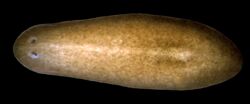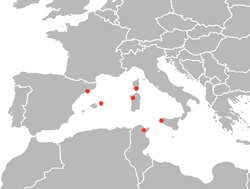Biology:Schmidtea mediterranea
| Schmidtea mediterranea | |
|---|---|

| |
| Scientific classification | |
| Domain: | Eukaryota |
| Kingdom: | Animalia |
| Phylum: | Platyhelminthes |
| Order: | Tricladida |
| Family: | Dugesiidae |
| Genus: | Schmidtea |
| Species: | S. mediterranea
|
| Binomial name | |
| Schmidtea mediterranea Benazzi, Baguñà, Ballester, Puccinelli & Del Papa, 1975
| |

| |
| Distribution of S. mediterranea (Western Mediterranean)[1] | |
| Synonyms | |
| |
Schmidtea mediterranea is a freshwater triclad that lives in southern Europe and Tunisia.[2] It is a model for regeneration, stem cells and development of tissues such as the brain and germline.[3][4]
Distribution
Schmidtea mediterranea is found in some coastal areas and islands in the western Mediterranean (Catalonia, Menorca, Mallorca, Corsica, Sardinia, Sicily and Tunisia).[2][5][6][7][8]
Ecology
High water temperatures of 25–27 °C have deleterious effects on populations of S. mediterranea, while this species tolerates variations in the acidity of the water (pH 6.9–8.9) without a noticeable influence on their survival.[2]
S. mediterranea can be found with associated fauna such as gastropods, bivalves, insects, leeches, and nematodes.[2]
Reproduction
The sexual specimens of Schmidtea mediterranea produce cocoons between November and April. In May, when water temperature rises above 20 °C, they lose their reproductive apparatus. Despite this, they don't reproduce asexually (by fissiparity) during the summer months.[2]
Research
Almost any piece from a Schmidtea mediterranea individual can regenerate an entire organism in a few days.[5] This is in part enabled by the presence of abundant pluripotent stem cells[9] called neoblasts. Transplantation of a single neoblast to a fatally injured animal has been shown to rescue the animal[9]
An analysis of the genome of S. mediterranea indicated the presence of a previously unknown family of long terminal repeats and the lack of several essential genes, including genes responsible for the synthesis of fatty acids and the MAD1 and MAD2 genes, which were thought to be essential components of the spindle assembly checkpoint.[10]
References
- ↑ E.M. Lazaro, A.H. Harrath, G.A. Stocchino, M. Pala, J. Baguna, M. Riutort, Schmidtea mediterranea phylogeography: an old species surviving on a few Mediterranean islands?, BMC Evolutionary Biology. 11 (2011) 274.
- ↑ 2.0 2.1 2.2 2.3 2.4 Abdel Halim Harrath; Mohamed Charni; Ronald Sluys; Fathia Zghal; Saida Tekaya (2004). "Ecology and distribution of the freshwater planarian Schmidtea mediterranea in Tunisia". Italian Journal of Zoology 71 (3): 233–236. doi:10.1080/11250000409356577.
- ↑ Salo E, Baguñà J: Regeneration in planarians and other worms: New findings, new tools, and new perspectives. Journal of Experimental Zoology 2002, 292(6):528-539.
- ↑ Reddien PW, Sanchez-Alvarado A: Fundamentals of planarian regeneration. Annu Rev Cell Dev Biol 2004, 20:725-757.
- ↑ 5.0 5.1 Benazzi M, Baguñà J, Ballester R, Puccinelli I, Papa RD: Further Contribution to the Taxonomy of the Dugesia lugubris-polychroa Group with Description of Dugesia mediterranea n. sp. (Tricladida, Paludicola). Bolletino di zoologia 1975, 42(1):81-89.
- ↑ Ribas M: Cariologia, sistematica i biogeografia de les Planaries d'aigues dolces al Països Catalans. 1990.
- ↑ Baguñà J. Carranza S, Pala M, Ribera C, Giribet G, Arnedo M, Ribas M, Riutort M: From morphology and kariology to molecules. New methods for taxonomical identification of asexual populations of freshwater planarians. A tribute to Professor Mario Benazzi. Italian Journal of Zoology 1999, 66:207-214.
- ↑ De Vries EJ, Baguñà J, Ball IR: Chromosomal polymorphism in planarians and the plate tectonics of the western Mediterranean. Genetica 1984, 62:187-191.
- ↑ 9.0 9.1 Wagner, Daniel E.; Wang, Irving E.; Reddien, Peter W. (2011-05-13). "Clonogenic Neoblasts Are Pluripotent Adult Stem Cells That Underlie Planarian Regeneration" (in en). Science 332 (6031): 811–816. doi:10.1126/science.1203983. ISSN 0036-8075. PMID 21566185.
- ↑ Grohme, M. A.; Schloissnig, S.; Rozanski, A.; Pippel, M.; Young, G. R.; Winkler, S.; Brandl, H.; Henry, I. et al. (2018). "The genome of Schmidtea mediterranea and the evolution of core cellular mechanisms". Nature 554 (7690): 56–61. doi:10.1038/nature25473. PMID 29364871.
External links
Wikidata ☰ Q2158498 entry
 |

